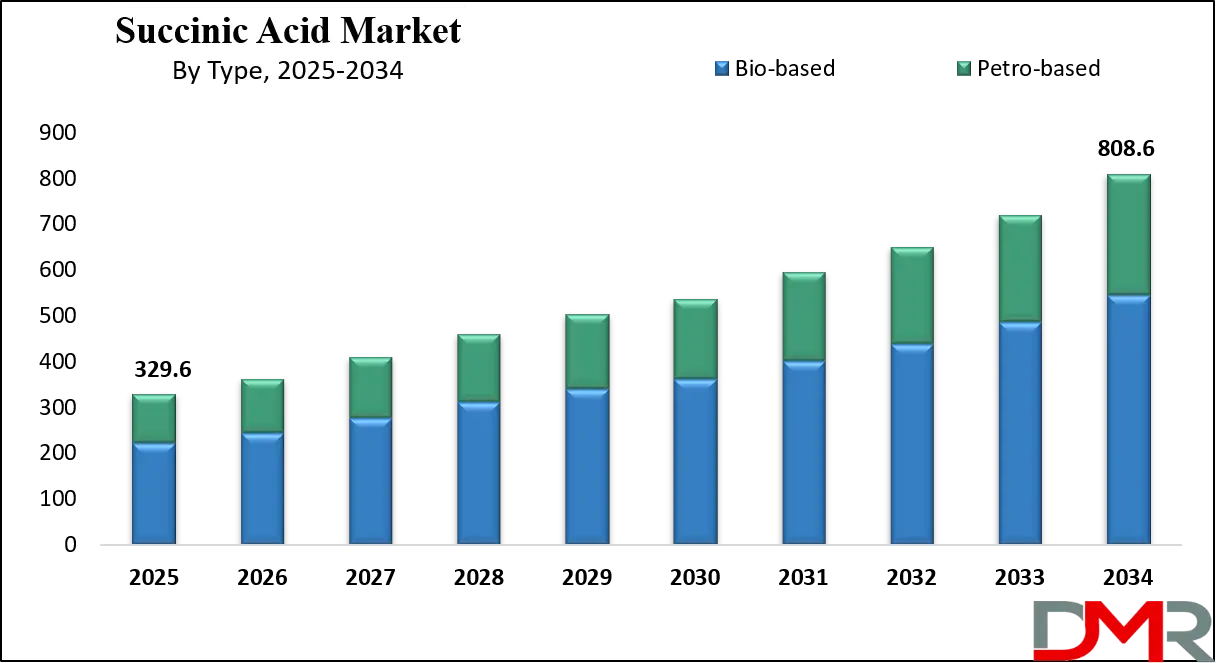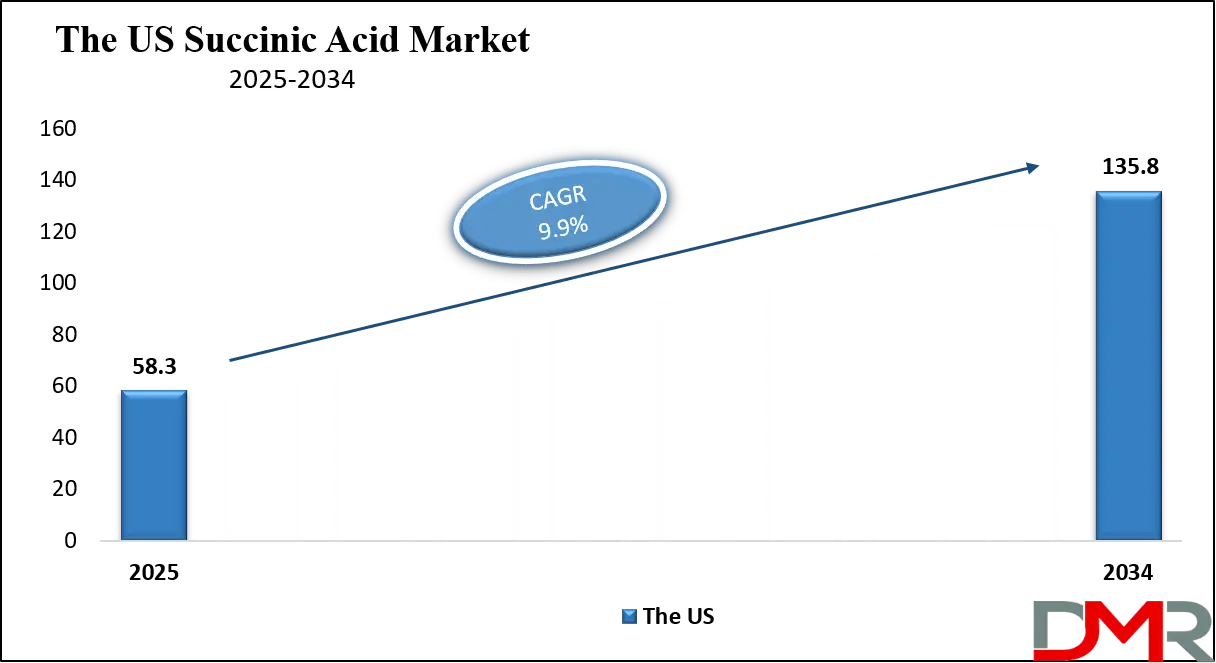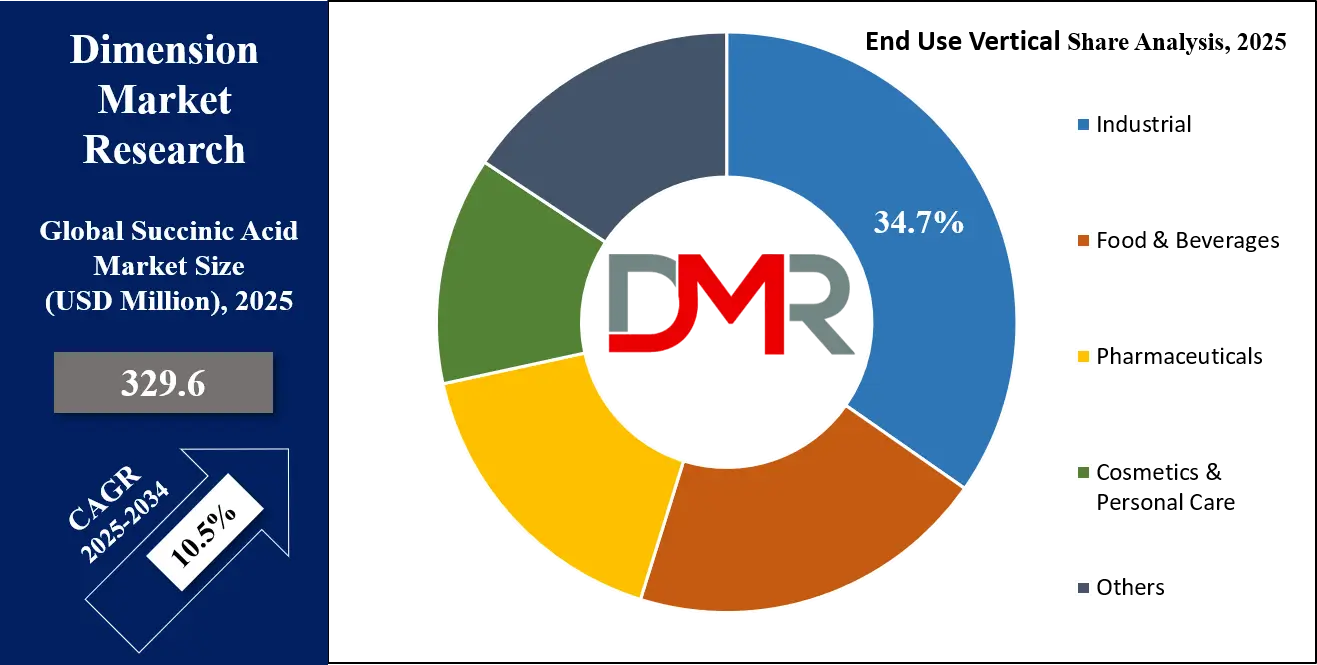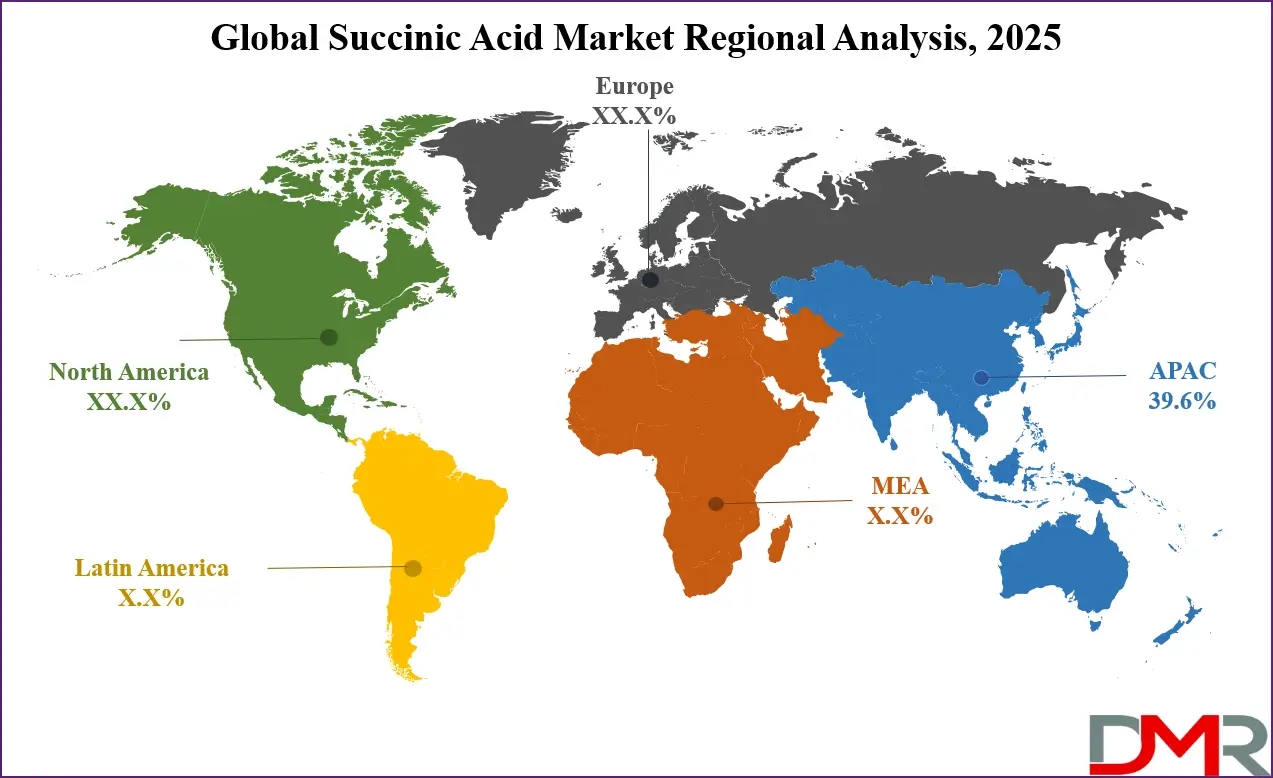Market Overview
The Global Succinic Acid Market size is projected to reach USD 329.6 million in 2025 and grow at a compound annual growth rate of 10.5% from there until 2034 to reach a value of USD 808.6 million.
Succinic acid is a four-carbon dicarboxylic acid that occurs naturally in many plants and animals. It is commonly used in the production of plastics, resins, coatings, and pharmaceuticals, which also play a role in the food and beverage industry as an acidity regulator and flavor enhancer. More recently, it has gained attention as a sustainable alternative to petroleum-based chemicals because it can be produced from renewable resources using microbial fermentation.

In recent years, demand for succinic acid has grown steadily, driven by industries looking for more eco-friendly materials. The push for bio-based chemicals has led many companies to switch from traditional fossil-fuel methods to bio-based production. This shift has made succinic acid especially appealing for packaging, biodegradable plastics, and personal care products. As a result, many companies and research organizations have invested in improving the efficiency and scale of bio-based succinic acid production.
A major trend in the succinic acid market is the rise of green chemistry, which focuses on reducing waste and harmful emissions by using cleaner production techniques. Succinic acid fits well with this philosophy because it can be made from agricultural waste or sugar-based feedstocks through fermentation. Biorefineries are now exploring ways to make succinic acid production more cost-effective and scalable, which is essential for meeting the rising demand across multiple sectors.
There have been several key developments in recent years that have shaped the market. Many startups and large chemical firms have partnered to improve production technologies. Governments in different countries have also introduced policies to encourage the use of sustainable chemicals, further boosting interest in succinic acid. In some regions, the use of succinic acid in biodegradable plastics has received regulatory support, helping it enter new applications.

Despite the positive momentum, challenges remain. One issue is the competition between bio-based and petroleum-based succinic acid, especially in terms of cost and availability. Another challenge is the need for better infrastructure and technology to scale up production efficiently. Still, with ongoing research and collaboration, the outlook remains optimistic.
The US Succinic Acid Market
The US Succinic Acid Market size is projected to reach USD 58.3 million in 2025 at a compound annual growth rate of 9.9% over its forecast period.
The US plays a significant role in the succinic acid market, largely due to its strong focus on innovation and sustainability. Many research institutions and companies in the US are actively developing advanced bio-based production technologies to improve efficiency and reduce costs. The country’s supportive regulatory environment encourages the use of renewable chemicals, which helps boost demand for bio-based succinic acid in various industries such as packaging, automotive, and pharmaceuticals.
Additionally, the US has a well-established infrastructure for biotechnology and fermentation processes, allowing for large-scale production and supply. As global interest in sustainable materials grows, the US is expected to remain a key player, driving technological advancements and expanding the market for succinic acid both domestically and internationally.

Europe Succinic Acid Market
Europe Succinic Acid Market size is projected to reach USD 82.4 million in 2025 at a compound annual growth rate of 9.4% over its forecast period.
Europe plays a crucial role in the succinic acid market by leading the push toward sustainability and green chemistry. Many European countries have strict environmental regulations that encourage the use of bio-based and biodegradable chemicals, boosting demand for succinic acid. The region is home to numerous research centers and companies focused on developing eco-friendly production methods, such as fermentation from renewable resources. Europe’s strong emphasis on reducing plastic waste and carbon emissions has also accelerated the adoption of succinic acid in biodegradable plastics and packaging.
Additionally, government incentives and funding support innovation in this field. With its commitment to a circular economy and sustainable development, Europe is expected to remain a major market and innovation hub for succinic acid globally.
Japan Succinic Acid Market
Japan Succinic Acid Market size is projected to reach USD 13.2 million in 2025 at a compound annual growth rate of 11.5% over its forecast period.
Japan plays an important role in the succinic acid market by focusing on advanced technology and innovation in sustainable chemicals. Japanese companies and research institutions are actively working on improving bio-based production methods to make succinic acid more efficient and cost-effective. The country’s strong emphasis on environmental protection and reducing dependence on fossil fuels supports the growth of bio-based chemicals like succinic acid.
Japan also uses succinic acid in various industries, including automotive, electronics, and pharmaceuticals, where high-quality and environmentally friendly materials are in demand.
Additionally, government policies promoting green technology and circular economy principles encourage the development and use of sustainable products. Japan’s focus on innovation and sustainability makes it a key player in expanding the global succinic acid market.
Succinic Acid Market: Key Takeaways
- Market Growth: The Succinic Acid Market size is expected to grow by USD 448.0 million, at a CAGR of 10.5%, during the forecasted period of 2026 to 2034.
- By Type: The bio-based segment is anticipated to get the majority share of the Succinic Acid Market in 2025.
- By End Use Vertical: The industrial segment is expected to get the largest revenue share in 2025 in the Succinic Acid Market.
- Regional Insight: Asia Pacific is expected to hold a 39.6% share of revenue in the Global Succinic Acid Market in 2025.
- Use Cases: Some of the use cases of Succinic Acid include the food & beverage industry, pharmaceutical applications, and more.
Succinic Acid Market: Use Cases
- Biodegradable Plastics: Succinic acid is used to make bio-based polymers like polybutylene succinate (PBS), which are biodegradable and help reduce plastic pollution. These plastics are used in packaging, agricultural films, and disposable products. The eco-friendly nature of PBS supports global efforts to reduce reliance on fossil-fuel plastics.
- Food and Beverage Industry: In food products, succinic acid acts as a flavor enhancer and acidity regulator. It is used in items like sauces, beverages, and baked goods to add a slight sour taste and maintain pH balance. Its approval as a food additive in many regions supports its safe and effective use in everyday products.
- Pharmaceutical Applications: Succinic acid is a building block in the production of active pharmaceutical ingredients (APIs). It helps in the formulation of pain relief drugs, antibiotics, and vitamins. Its role in drug development highlights its importance in ensuring product stability and effectiveness.
- Cosmetics and Personal Care: This compound is used in skincare and personal hygiene products for its moisturizing and pH-balancing properties. It also helps prevent bacterial growth, making it useful in acne treatments and lotions. Succinic acid's mild nature makes it suitable for sensitive skin formulations.
Market Dynamic
Driving Factors in the Succinic Acid Market
Rising Demand for Sustainable and Bio-Based Products
One of the main growth drivers for the succinic acid market is the increasing global focus on sustainability and eco-friendly products. Consumers and industries alike are seeking alternatives to traditional petroleum-based chemicals due to environmental concerns and stricter regulations. Succinic acid, produced through bio-based fermentation processes using renewable resources like agricultural waste and sugars, fits perfectly into this shift. Its use in biodegradable plastics, bio-resins, and green solvents is becoming more popular, especially in the packaging and personal care sectors. As more companies adopt green chemistry practices, the demand for bio-based succinic acid is expected to grow steadily, encouraging investments in production technology and capacity expansion.
Expansion of End-Use Industries and Applications
The succinic acid market is also growing because of its increasing applications across various industries. Besides its traditional use in plastics and pharmaceuticals, new uses are emerging in food and beverages as a natural acidity regulator and flavor enhancer. The cosmetics industry is also adopting succinic acid for its skin-friendly and antibacterial properties.
Additionally, the rise of biodegradable and bio-based products in the agriculture and automotive sectors is creating fresh opportunities. As more end-use industries recognize the benefits of succinic acid, the market is likely to see steady growth, supported by innovation and product development tailored to diverse customer needs.
Restraints in the Succinic Acid Market
High Production Costs Compared to Petrochemical Alternatives
One big restraint in the succinic acid market is the relatively high cost of bio-based production compared to traditional petrochemical methods. Although succinic acid can be produced from renewable resources, the fermentation process requires advanced technology and specialized equipment, which can drive up expenses. These higher costs often make bio-based succinic acid less competitive in price-sensitive markets.
Additionally, fluctuations in the availability and price of raw materials like sugars or agricultural waste can impact production costs. Until the manufacturing process becomes more efficient and economies of scale are achieved, cost remains a major barrier to wider adoption in certain industries.
Challenges in Scaling Up Production and Supply Chain Limitations
Another challenge for the succinic acid market is the difficulty in scaling up production to meet growing demand. While lab-scale fermentation and pilot projects have shown promise, commercial-scale production still faces technical and logistical hurdles. Setting up large biorefineries requires significant capital investment and time, and ensuring a steady supply of raw materials can be complicated due to seasonal variations and competing uses.
Moreover, the infrastructure for the distribution and storage of bio-based chemicals is less developed in some regions, which can slow down market growth. These supply chain and scale-up challenges limit the availability and consistent supply of succinic acid products in the global market.
Opportunities in the Succinic Acid Market
Growing Demand for Biodegradable and Eco-Friendly Packaging
One promising opportunity for the succinic acid market lies in the increasing demand for biodegradable and sustainable packaging solutions. As governments and consumers become more aware of the environmental impact of traditional plastics, there is a strong push to replace them with bio-based alternatives. Succinic acid is a key ingredient in making biodegradable polymers like polybutylene succinate (PBS), which can break down naturally without harming the environment. This trend is opening up new markets in food packaging, agricultural films, and disposable products. Companies that invest in developing cost-effective and high-quality bio-based packaging materials can capitalize on this growing demand.
Advancements in Fermentation Technology and Raw Material Innovation
Technological advancements in fermentation processes offer significant growth potential for the succinic acid market. New strains of microorganisms and improved fermentation techniques can increase yield and reduce production costs, making bio-based succinic acid more competitive.
Additionally, exploring alternative raw materials such as lignocellulosic biomass, food waste, and industrial by-products can provide cheaper and more sustainable feedstocks. These innovations can help scale production efficiently while minimizing environmental impact. With ongoing research and development, producers can unlock new opportunities to expand their product range and enter new industries that require green chemical solutions.
Trends in the Succinic Acid Market
Increased Demand for Biodegradable Plastics
A major trend in the succinic acid market is the growing demand for biodegradable plastics. Succinic acid serves as a key component in producing polybutylene succinate (PBS), a biodegradable polymer used in packaging, agricultural films, and disposable products. With global concerns over plastic pollution, industries are shifting towards sustainable materials, and PBS offers an eco-friendly alternative to traditional plastics. The adoption of PBS is further supported by regulatory pressures and consumer preference for environmentally friendly products. This trend is driving the growth of the succinic acid market, as it becomes integral in the production of biodegradable plastics.
Advancements in Fermentation Technology
Another notable trend is the advancement in fermentation technologies for succinic acid production. Innovations in microbial engineering and fermentation processes have enhanced the efficiency and yield of bio-based succinic acid. These technological improvements make bio-based succinic acid more competitive with petrochemical-derived alternatives by reducing production costs and increasing scalability.
The development of genetically engineered microorganisms capable of producing higher yields of succinic acid from renewable feedstocks is a key factor in this advancement. These technological strides are pivotal in meeting the rising demand for sustainable chemicals and expanding the applications of succinic acid across various industries.
Research Scope and Analysis
By Type Analysis
Bio-based succinic acid is expected to lead the market in 2025 with a share of 67.5%, driven by the growing demand for eco-friendly and renewable chemicals. This segment is gaining popularity as industries move away from petroleum-based products to more sustainable alternatives. Bio-based production uses renewable feedstocks like agricultural waste and sugars, reducing carbon emissions and dependency on fossil fuels. The use of bio-based succinic acid is expanding in biodegradable plastics, resins, personal care products, and pharmaceuticals.
Government policies supporting green chemicals and increasing consumer awareness are further encouraging its adoption. With rising environmental concerns and advancements in fermentation technologies, the bio-based segment is set to play a major role in shaping the succinic acid market's future growth worldwide.
Petro-based succinic acid is expected to have significant growth over the forecast period due to its cost-effectiveness and established production infrastructure. Though bio-based options are gaining popularity, petro-based succinic acid remains important for industries that prioritize consistent supply and lower prices. It is widely used in traditional applications like resins, coatings, and plastics where cost control is essential.
The segment benefits from mature technology and easier raw material availability, which support large-scale production. While sustainability concerns are pushing for alternatives, petro-based succinic acid continues to be a reliable option for many manufacturers. Its role in meeting industrial demand makes it a steady contributor to the overall succinic acid market, even as the industry shifts toward greener alternatives.
By End Use Vertical Analysis
The industrial segment is set to lead the succinic acid market in 2025 with a projected share of 34.7%, supported by its wide use in manufacturing resins, coatings, dyes, and plasticizers. This segment benefits from succinic acid’s versatility in replacing traditional petrochemicals with more sustainable alternatives.
Industries are increasingly using bio-based succinic acid in processes that aim to lower environmental impact while maintaining high performance. The growing demand for eco-friendly and cost-efficient raw materials in construction, automotive, and textiles is also fueling the segment’s expansion. With rising regulatory pressure to reduce emissions and adopt greener inputs, the industrial segment is expected to continue playing a key role in driving market growth, especially as companies look to align with global sustainability standards.
Further, the cosmetics & personal care segment is having significant growth over the forecast period due to the rising preference for natural and skin-safe ingredients. Succinic acid is gaining attention in this space for its gentle, antibacterial, and pH-balancing properties. It is widely used in skincare products like creams, acne treatments, and cleansers.
The growing trend toward clean beauty and sustainable personal care products is encouraging manufacturers to choose bio-based ingredients, boosting the demand for succinic acid. With consumers seeking effective yet mild formulations, this segment is expanding rapidly across global markets. Its compatibility with sensitive skin and environmental benefits make it a valuable choice in both premium and everyday cosmetic applications.

The Succinic Acid Market Report is segmented on the basis of the following:
By Type
- Bio-based Succinic Acid
- Petro-based Succinic Acid
By End Use Vertical
- Industrial
- Food & Beverage
- Pharmaceuticals
- Cosmetics & Personal Care
- Others
Regional Analysis
Leading Region in the Succinic Acid Market
Asia Pacific will be leading the growth of the succinic acid market in 2025, holding a significant share of about 39.6%. The region’s rapid industrialization and growing awareness of sustainable products are driving demand for bio-based succinic acid. Countries in the Asia Pacific are investing heavily in green technologies and fermentation processes, making the production of succinic acid more efficient and cost-effective. The expanding packaging, food and beverage, and pharmaceutical industries are using more eco-friendly materials, which supports market growth.
Additionally, government initiatives promoting renewable chemicals and reducing plastic waste are encouraging companies to adopt succinic acid in their products. The availability of raw materials such as agricultural waste and sugars in the region also helps reduce production costs. With ongoing innovation and increasing consumer interest in biodegradable products, the Asia Pacific region is playing a key role in shaping the global succinic acid market this year.

Fastest Growing Region in the Succinic Acid Market
Latin America is showing significant growth in the succinic acid market over the forecast period due to increasing investments in bio-based chemical production. The region benefits from abundant agricultural resources, providing low-cost raw materials for sustainable succinic acid manufacturing. Growing awareness about environmental issues and government support for green technologies are encouraging industries to shift towards eco-friendly alternatives. The expanding packaging, personal care, and pharmaceutical sectors in Latin America are also driving demand for biodegradable and renewable chemicals like succinic acid. With advancements in fermentation technology and rising adoption of bio-based products, the region is estimated to play an important role in the global market’s growth in the coming years.
By Region
North America
Europe
- Germany
- The U.K.
- France
- Italy
- Russia
- Spain
- Benelux
- Nordic
- Rest of Europe
Asia-Pacific
- China
- Japan
- South Korea
- India
- ANZ
- ASEAN
- Rest of Asia-Pacific
Latin America
- Brazil
- Mexico
- Argentina
- Colombia
- Rest of Latin America
Middle East & Africa
- Saudi Arabia
- UAE
- South Africa
- Israel
- Egypt
- Rest of MEA
Competitive Landscape
The competitive landscape of the succinic acid market is shaped by a mix of traditional chemical producers and newer bio-based companies. As demand grows for eco-friendly products, many producers are focusing on using renewable raw materials and cost-efficient fermentation methods. Some companies are expanding production capacity, while others are investing in research to improve yield and reduce costs.
The market also sees competition in pricing, product quality, and supply reliability. Players are forming partnerships and licensing agreements to share technology and access new regions. With sustainability becoming more important worldwide, companies that can offer consistent, high-quality, and environmentally friendly succinic acid have a better chance of gaining an edge in this changing market environment.
Some of the prominent players in the global Succinic Acid are:
- BASF SE
- Mitsubishi Chemical
- DSM
- Reverdia
- Green Biologics
- MercK
- Alfa Aesar
- BOC Sciences
- AK Scientific
- Myriant Corporation
- Roquette Frères
- Shanghai Vico Industrial Co., Ltd.
- Combi-Blocks Inc.
- Biovon Biochemicals
- Nacalai Tesque, Inc.
- AppliChem GmbH
- MP Biomedicals
- Other Key Players
Recent Developments
- In May 2025, Aesthetic manufacturer mesoestetic launched its new filler range mesofiller nexha is now available in the UK, as its new launch comprises MesoFiller Nexha volume and MesoFiller Nexha lips, with rheologies tailored for different areas. The fillers combine hyaluronic acid with succinic acid, a biostimulator with antioxidant and regenerative properties. The products contain dual release technology to release active ingredients in two phases, with mesoestetic saying this means their action can be extended for up to seven months.
Report Details
| Report Characteristics |
| Market Size (2025) |
USD 329.6 Mn |
| Forecast Value (2034) |
USD 808.6 Mn |
| CAGR (2025–2034) |
10.5% |
| The US Market Size (2025) |
USD 58.3 Mn |
| Historical Data |
2019 – 2024 |
| Forecast Data |
2026 – 2034 |
| Base Year |
2024 |
| Estimate Year |
2025 |
| Report Coverage |
Market Revenue Estimation, Market Dynamics, Competitive Landscape, Growth Factors, etc. |
| Segments Covered |
By Type (Bio-based Succinic Acid and Petro-based Succinic Acid), By End Use Vertical (Industrial, Food & Beverage, Pharmaceuticals, Cosmetics & Personal Care, and Others) |
| Regional Coverage |
North America – US, Canada; Europe – Germany, UK, France, Russia, Spain, Italy, Benelux, Nordic, Rest of Europe; Asia-Pacific – China, Japan, South Korea, India, ANZ, ASEAN, Rest of APAC; Latin America – Brazil, Mexico, Argentina, Colombia, Rest of Latin America; Middle East & Africa – Saudi Arabia, UAE, South Africa, Turkey, Egypt, Israel, Rest of MEA |
| Prominent Players |
BASF SE, Mitsubishi Chemical, DSM, Reverdia, Green Biologics, MercK, Alfa Aesar, BOC Sciences, AK Scientific, Myriant Corporation, Roquette Frères, Shanghai Vico Industrial Co., Ltd., Combi-Blocks Inc., Biovon Biochemicals, Nacalai Tesque, Inc., AppliChem GmbH, MP Biomedicals, and Other Key Players
|
| Purchase Options |
We have three licenses to opt for: Single User License (Limited to 1 user), Multi-User License (Up to 5 Users), and Corporate Use License (Unlimited User) along with free report customization equivalent to 0 analyst working days, 3 analysts working days, and 5 analysts working days respectively. |
Frequently Asked Questions
The Global Succinic Acid Market size is expected to reach a value of USD 329.6 million in 2025 and is expected to reach USD 808.6 million by the end of 2034.
Asia Pacific is expected to have the largest market share in the Global Succinic Acid Market, with a share of about 39.6% in 2025.
The Succinic Acid Market in the US is expected to reach USD 58.3 million in 2025.
Some of the major key players in the Global Succinic Acid Market are BASF SE, Mitsubishi Chemical, DSM, and others
The market is growing at a CAGR of 10.5 percent over the forecasted period